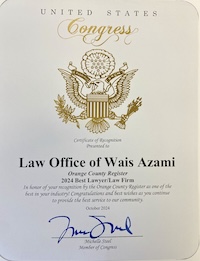- Free Consultation*: (714) 321-9999 Tap Here to Call Us
Find an officer’s prior bad behavior

Police officer’s past bad behavior can be discovered with the Brady Motion in your current case. Brady was a court case which caused the ruling for which there is now a motion. It forces disclosure of important facts about your officer’s prior dealings and tendencies. It helps the defense attack the reliability, thoroughness, or good faith of the police investigation.
The Brady Motion can be used for prying loose police reports that show:
-inconsistent behavior or statements by police
-incompetence or failure to follow guidelines or protocols for investigation, and
-general sloppiness in investigating the crime or in failing to follow leads or investigate anything that wouldn’t help convict your client.
It is also very useful for obtaining information about informants, deals and other crimes that may have given witnesses a motive to lie in your case, or given the police a motive to frame your client.
Even if something would not be admissible at trial, if it fits within the definition of Brady material, it must be disclosed. The key to Brady is that the defense must be given all favorable information it is then up to defense counsel to figure out a way, if possible, to use it. Contrary to what many prosecutors believe, the fact that a document or piece of information may be inadmissible does not relieve them of their obligation to disclose it under Brady.
Even if the prosecutor thinks that the Brady material is unreliable or unbelievable, he or she must disclose it. It is for defense counsel, not the prosecutor to decide whether the Brady material is reliable enough to be used. For example: the excuse that the other guy who confessed was crazy and unbelievable does not relieve the prosecution from the due process obligation to inform the defense about the other guy and his confession.
In Kyles v. Whitley, the U.S. Supreme Court explicitly said that the individual prosecutor has an affirmative duty to learn of any favorable evidence known to the other people and agencies acting on the government’s behalf on the case, including the police.
- Inconsistent descriptions by different witnesses of the criminal.
- Inconsistent descriptions by different witnesses of the crime.
- The fact that some of the witness’s descriptions of the criminal matched the police informant
- That there were pending charges against the police informant
- That there was an ongoing investigation of the police informant concerning other crimes.
- That the police informant made inconsistent statements to the police about the crime and about his accusation of the defendant
- That the police had other leads and information that they failed to follow up on or investigate, that could have pointed the finger at someone other than the defendant.
- That before accusing the defendant, one of the witnesses previously said that she had not actually seen the crime
- That a witness’s description of the crime and/or the criminal became more “accurate†and more certain after the witness met with police and/or prosecutors, or after the witness testified at a first hearing or trial.
- That a witness’s prior statements omit significant details or facts that the witness remembered at trial.
- That a witness’s trial testimony omitted significant details or facts that the witness mentioned in prior statements.
- That a witness or informant made statements that incriminated himself in the crime charged against the defendant.
Call the Law Office of Wais Azami with any questions. We offer free consultations and flexible appointment times.
This information shall not be deemed legal advice, nor shall it create any attorney-client relationship. It is merely for informational purposes or academic purposes.













